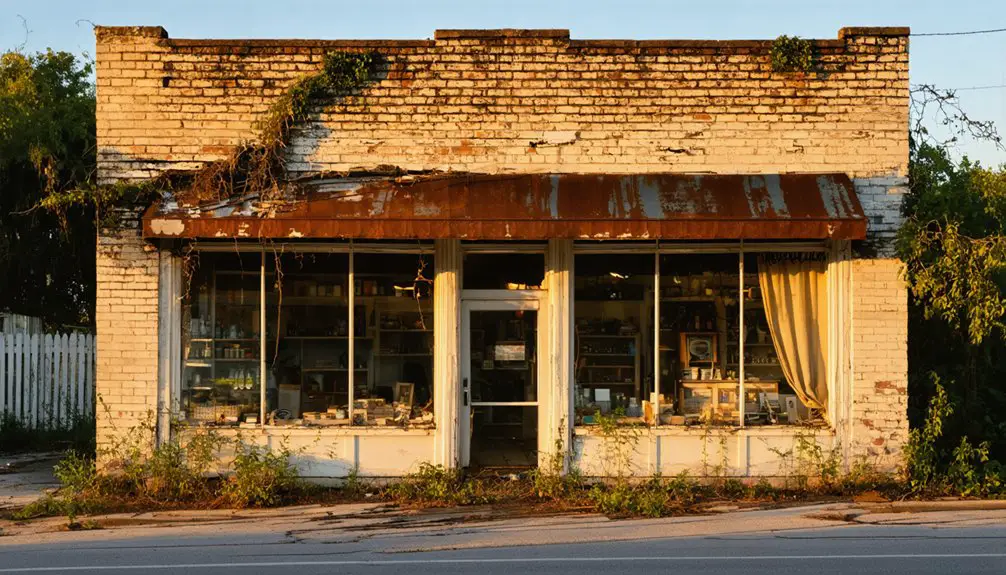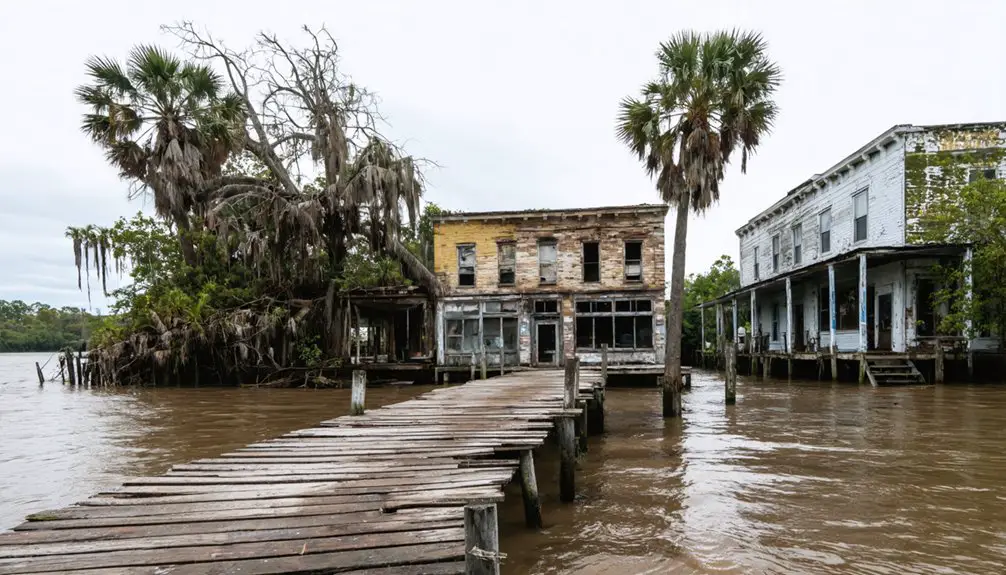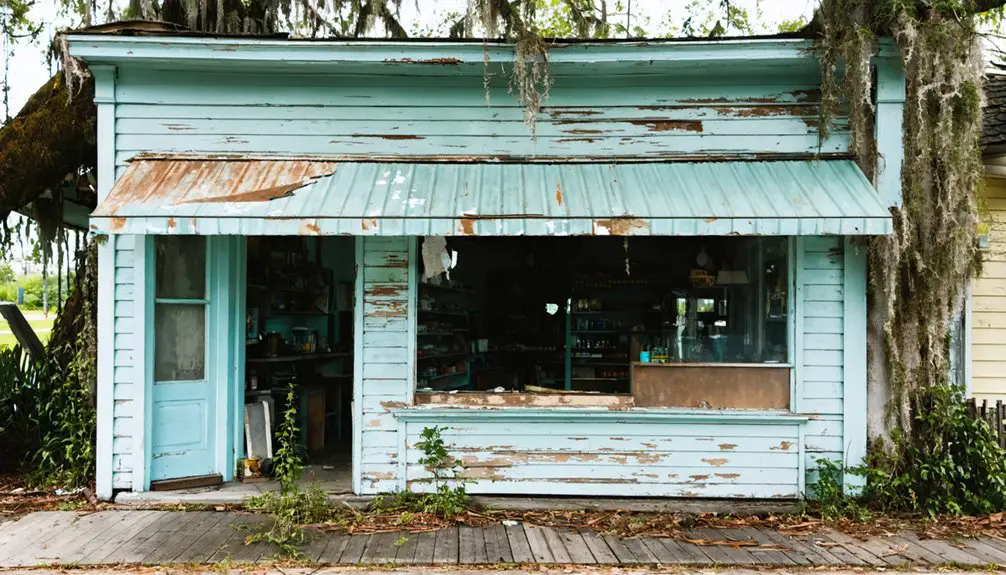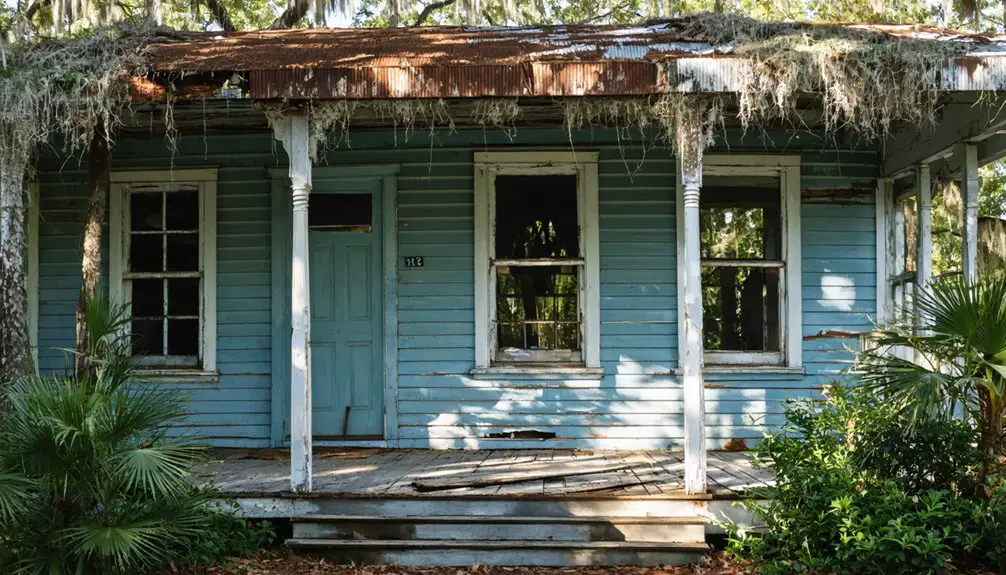You’ll find Old Town’s haunting remains along Florida’s Suwannee River, where Henry Flagler’s ambitious railroad dreams once transformed this Indigenous settlement into a thriving commercial hub. In the 1890s, the Florida East Coast Railway brought unprecedented prosperity through lumber, turpentine, and tourism industries. After devastating hurricanes in the 1920s crashed the real estate market, Old Town’s glory faded. Today, crumbling foundations and weathered structures tell tales of Florida’s dramatic boom-and-bust legacy.
Key Takeaways
- Old Town, established in 1811, was the last platted settlement in the Western Hemisphere for a decade.
- The arrival of Flagler’s railroad in 1895 initially brought prosperity through lumber, agriculture, and tourism industries.
- Economic collapse followed the 1926 and 1928 hurricanes, causing businesses to close and residents to relocate.
- Nature reclaimed the abandoned town, with saw palmettos and scrub pines growing through building foundations.
- Few original structures remain standing, primarily railroad station remnants and wooden frame buildings from the late 1800s.
Early Settlement and Origins
Before becoming a ghost town, Old Town, Florida began as indigenous territory inhabited by the Timucua and Seminole peoples, who established thriving villages and trade networks centuries before European arrival.
When Spanish explorers arrived in the 16th century, they encountered welcoming Indigenous interactions, with Timucua sharing their resources and participating in months of cultural exchange.
Pedro Menéndez de Avilés’s founding of nearby St. Augustine in 1565 sparked Spanish settlement in the region. Like early Spanish Pensacola, the area provided rich hunting and fishing grounds for native tribes. The town was officially established in 1811 and became the last platted settlement in the Western Hemisphere for a decade. Following the Law of the Indies, settlers established Old Town with distinctive Spanish architecture, featuring a central plaza facing the Amelia River’s deep-water port.
The settlement served as a strategic foothold, balancing military defense with maritime commerce. You’ll find evidence of this legacy in the archaeological remains of fortifications that were abandoned after the United States acquired Florida in 1821.
Railroad’s Golden Era
While Old Town’s early development centered on maritime trade, the arrival of Henry Flagler‘s Florida East Coast Railway in 1895 transformed the region during Florida’s railroad golden era.
The railroad expansion brought unprecedented economic impact to Florida’s east coast communities, fundamentally reshaping transportation and commerce. Steamer towns quickly transformed into bustling fishing villages as the rail networks expanded. The railroad’s $fifty million investment in infrastructure and expansion demonstrated Flagler’s commitment to developing Florida’s transportation network.
- You’d witness up to 12 daily passenger trains thundering between Jacksonville and Miami
- You’d see new bridges spanning waterways, including the impressive Strauss Trunnion Bascule Bridge
- You’d find flourishing agriculture and lumber industries connected by rail to northern markets
- You’d explore Flagler’s growing network of luxurious hotels catering to winter tourists
- You’d experience the excitement of modern block signaling and double-tracked mainlines
The railway’s influence reached far beyond transportation, laying the foundation for Florida’s future development and forever changing Old Town’s economic landscape.
Natural Beauty and Geography
When you visit Old Town today, you’ll find rich natural beauty defined by the mighty Suwannee River‘s cypress-lined banks and strategically placed access points that once served steamboat traffic.
You’ll encounter dense thickets of saw palmetto and scrub pine characteristic of Florida’s wild landscape, while mangroves dominate the coastal wetland areas. Much like the largest logged trees that once defined Brooksville’s landscape, these natural features shape the region’s character. The constant battle against encroaching jungle reflects the ongoing struggle between human settlement and Florida’s powerful natural elements.
The surrounding ecosystem supports diverse wildlife, including native songbirds and aquatic species that thrive in the river-wetland interface where human settlement once stood.
Suwannee River Access Points
The Suwannee River offers several key access points near Old Town, with Suwannee River State Park serving as a primary gateway to this historic waterway.
You’ll find a well-maintained boat ramp accessible via dirt roads, though you’ll need to watch for sandy or washboard conditions. For paddling access, you’ve got multiple options along the river’s course. The river flows from the Okeefenokee Swamp in Georgia all the way to the Gulf of Mexico.
- Gibson Park at mile 136 provides direct river entry
- Seven Sisters launch point sits at mile 131
- Anderson Springs Tract offers access plus mountain biking trails
- Madison Blue Springs State Park features a hand-launch site
- CR 145 Bridge near the Georgia line marks the paddling trail’s start
Remember to check water levels, as shoals can become impassable below 54 feet gauge. Visitors can enjoy five River Camps with modern amenities including air-conditioned bathrooms and electricity.
Overnight parking is permitted at Suwannee River State Park, but not at Madison Blue Springs.
Local Flora and Wildlife
Beyond the river’s edge, rich biodiversity flourishes throughout Old Town’s abandoned spaces.
You’ll find native plants like longleaf and slash pines dominating the landscape, while saw palmetto creates dense understory cover. In wet pockets, cypress trees stand as remnants of former swamps, and around old homesites, live oaks and magnolias have taken root. Similar to abandoned Port Charlotte neighborhoods, these deserted areas have become sanctuaries for native vegetation.
The area’s wildlife habitats support an array of creatures. White-tailed deer browse along forest edges, while red-shouldered hawks patrol overhead. The quiet Florida wilderness provides a pristine natural sanctuary.
You’ll spot gopher tortoises in sandy uplands and hear tree frogs calling from seasonal wetlands. The flat, well-drained terrain creates perfect conditions for wildflowers like coreopsis and wild indigo, while natural succession gradually reclaims former clearings, transforming them into young pine forests teeming with songbirds and small mammals.
Coastal Wetland Ecosystems
Stretching along Florida’s southwest coast, Old Town’s coastal wetlands form part of an intricate ecosystem less than a few meters above sea level.
You’ll find these pristine areas are critical targets for wetland restoration efforts, protecting both wildlife and coastal communities. The region’s natural water flow, though altered by human activity since the 1800s, still supports diverse habitats worthy of preservation.
- Ancient mangrove forests create natural barriers against storms and erosion
- Salt marshes span thousands of acres, offering sanctuary for native species
- Cypress swamps border the eastern flatwoods, adding to the area’s wild character
- Coastal prairies naturally defend against saltwater intrusion
- Estuarine forests showcase Florida’s largest mangrove system in the Ten Thousand Islands
These ecosystems represent some of the last truly wild places in Florida, demanding your attention for habitat preservation.
Economic Rise and Fall

During Florida’s famed 1920s land boom, Old Town experienced a dramatic economic evolution as real estate speculation and tourism aspirations drove property values to unprecedented heights.
You’d have seen properties skyrocket to fifty times their original value as investors poured in, drawn by improved rail access and aggressive development promotions.
This economic speculation came crashing down when the devastating hurricanes of 1926 and 1928 struck Florida.
The real estate collapse that followed hit Old Town particularly hard, as tourism shifted to larger coastal cities.
You’ll find that the town’s shift from agriculture to tourism left it vulnerable when the market bottomed out.
Local businesses shuttered, residents moved away, and abandoned developments became common sights, marking Old Town’s descent into economic decline.
Local Industries That Shaped Growth
The economic tapestry of Old Town was woven from several key industries that defined its early development.
You’ll find the logging impact was particularly significant, with vast timber resources fueling sawmill operations that employed many residents. The turpentine legacy remains visible through artifacts like Herty cups, as workers extracted valuable pine resin that became Florida’s largest industry at the time.
- You can still discover old glass and sawmill debris scattered across former industrial sites
- The railroad’s presence transformed Old Town into a bustling hub for timber transport
- Turpentine production offered vital supplemental income for local farmers
- Citrus challenges, particularly the devastating freezes of 1894-95, forced agricultural adaptations
- Mining influence brought transient workers and spurred infrastructure development, though resources eventually depleted
Environmental Challenges

As environmental forces relentlessly battered Old Town, nature steadily reclaimed its territory through a combination of aggressive vegetation growth and severe weather events.
Nature’s unyielding siege transformed Old Town into wilderness, as plants and storms conspired to erase human footprints from the land.
You’ll find saw palmettos and scrub pines pushing through crumbling foundations, while the humid subtropical climate accelerates environmental degradation. The corrosive sea air and constant moisture rot wooden structures, leaving little evidence of human habitation.
Wildlife conservation efforts highlight the area’s transformation into a natural sanctuary, where black bears and wild turkeys now roam freely.
You’ll need to watch for rattlesnakes and other venomous creatures that have made the abandoned structures their home. Recurring hurricanes and flooding continue to reshape the landscape, making any attempts at preservation a constant battle against nature‘s persistent reclamation of its domain.
Historical Landmarks and Structures
You’ll find few intact structures in Old Town today, though fragments of its railroad station and accompanying infrastructure offer glimpses into the town’s transportation history.
Several wooden frame buildings, typical of late 1800s rural Florida architecture, remain standing despite decades of exposure to the elements.
The most significant surviving landmarks include deteriorating barns, abandoned homes, and agricultural structures that once supported the town’s farming and citrus operations.
Railroad Station Remnants
Railroad station remnants in Old Town stand as silent witnesses to a once-thriving transportation hub that connected this Florida settlement to regional markets in the late 19th and early 20th centuries.
The station’s railroad architecture featured the typical rectangular brick design with wooden gables and wide, protective eaves. You’ll find evidence of its station significance in the preserved elements that once facilitated the region’s economic growth.
- Wooden freight platforms stretched 40 feet, enabling efficient cargo operations
- Multiple freight doors showcased the building’s dual passenger-cargo functionality
- Telegraph and express offices marked the station’s essential communication role
- Steel reinforcements from 1940s renovations reveal adaptation to changing times
- Original brick construction demonstrates 19th-century industrial craftsmanship
These remnants tell the story of Old Town’s rise as a significant transportation nexus.
Historic Buildings Still Standing
Standing proudly against time’s erosion, Old Town’s historic landmarks showcase an impressive collection of 19th and early 20th-century architecture that spans maritime, military, and cultural significance.
You’ll discover architectural significance in every corner, from the towering 65-foot Key West Lighthouse to Fort Zachary Taylor’s formidable coastal defense structures.
The Custom House‘s red brick facade and the Oldest House Museum’s colonial Caribbean design tell tales of maritime wealth and ghostly encounters.
Along Mallory Square’s waterfront, Art Deco gems like The Studios of Key West and the Sidney M. Aronovitz Courthouse display striking limestone exteriors and terra cotta details.
The Casa Marina Resort stands as a symbol of tourism’s golden age, while the preserved Strand Theater and Tropic Cinema remind visitors of entertainment’s cultural legacy.
Community Life Through the Years

Life in Old Town, Florida revolved around a close-knit agricultural community where families worked together to sustain their modest but stable way of life.
You’d find the heart of social interaction centered around churches, schools, and community events that brought everyone together. Through seasonal festivals and harvest celebrations, neighbors forged lasting bonds that helped them weather life’s challenges.
- You could witness children learning in the small schoolhouse while their parents tended to crops and livestock.
- You’d experience the joy of community gatherings where stories and traditions were passed down.
- You’d find comfort in the mutual aid system where neighbors helped neighbors survive.
- You’d see families working side-by-side in the citrus groves during harvest season.
- You’d feel the strong sense of belonging at social gatherings in local churches.
Preservation Efforts Today
You’ll find impressive progress in Old Town’s preservation efforts, where historical buildings are being carefully restored using original architectural techniques and period-appropriate materials.
The Community Heritage Center now hosts monthly events featuring local historians and artifact displays that showcase the town’s cultural legacy.
Local schools participate in educational programs at restored sites, where students learn about pioneer life through hands-on activities and guided tours of preserved structures.
Historical Buildings Restoration Progress
While several historic structures remain throughout Old Town’s ghost settlements, preservation efforts vary considerably by location and face distinct challenges.
You’ll find restoration approaches similar to other Florida ghost towns, where historical significance and architectural styles must be balanced with practical limitations.
- Like Fort Dade, many original structures are deteriorating naturally, with preservation focused on stabilization rather than full restoration.
- Similar to Eldora’s approach, efforts prioritize maintaining existing structures while letting nature reclaim portions of the settlement.
- You’ll notice a preservation philosophy that mirrors Stiltsville’s strategy of protecting key structures while managing access.
- Restoration work emphasizes historical authenticity while adapting spaces for modern safety requirements.
- Current projects focus on strategic preservation of the most culturally significant buildings, much like Maggie Valley’s targeted approach.
Community Heritage Center Activities
Today’s heritage center serves as the beating heart of Old Town’s preservation movement, coordinating a diverse range of activities that connect visitors with the settlement’s rich past.
You’ll find extensive heritage programming throughout the year, from guided ghost tours to live demonstrations by local artisans practicing traditional crafts.
The center’s community workshops teach preservation techniques, while dedicated volunteers maintain historic sites and artifacts.
You can explore permanent exhibits showcasing archaeological finds, interact with displays depicting daily pioneer life, and access digitized archives of historical photographs and documents.
The center’s partnerships with universities and regional historical societies guarantee ongoing research and documentation of Old Town’s legacy.
Through social media and public meetings, you’re invited to contribute to preservation planning and event development.
Local Education Programs
Building on the heritage center’s mission, Old Town’s local education programs extend preservation awareness deep into the community.
You’ll find educational initiatives that bring history to life through hands-on experiences and modern technology. Community engagement thrives as schools incorporate ghost town modules into their curricula, while field trips and workshops connect students directly with their local heritage.
- Interactive archaeological surveys let you witness preservation in action
- Local historians lead cemetery walks, sharing authentic stories of past residents
- School programs utilize 3D mapping and drone footage for virtual exploration
- Volunteer opportunities allow you to participate in site maintenance and documentation
- Technology-driven learning platforms connect you with Old Town’s history through social media and podcasts
Cultural Heritage and Tourism
As a gateway to Dixie County’s cultural legacy, Old Town, Florida, offers visitors a unique blend of historical exploration and natural beauty.
You’ll discover a vibrant cultural identity through exhibits and events at the community center, where local history comes alive through interpretive programming and preserved artifacts.
The tourism impact extends beyond Old Town’s boundaries to nearby attractions like Suwannee River State Park and remnants of ghost towns like Rollo.
These sites tell stories of indigenous peoples, early settlers, and industries that shaped the region. You’ll find educational signage along hiking trails and scenic viewpoints that connect you to Florida’s past.
Follow the winding trails through Florida’s living history, where every marker reveals tales of those who shaped this land.
Local businesses benefit from this heritage tourism while preservation efforts guarantee these historic treasures remain accessible for future generations to explore.
Frequently Asked Questions
Are There Any Documented Paranormal Activities or Ghost Sightings in Old Town?
You’ll find documented ghost encounters at Old Town Manor, where Dr. Warren and Genevieve’s spirits roam the gardens, and EVP sessions have captured voices in the haunted locations, particularly the Garden room.
What Native American Artifacts Have Been Discovered in the Old Town Area?
Where there’s smoke, there’s fire, and you’ll find Native tools like bone implements, carved wooden stakes, and pottery throughout Old Town. Ancient burial artifacts include mammoth tusk spears and ceremonial copper pieces.
How Safe Is It to Explore Old Town’s Abandoned Structures Today?
You’ll face significant risks exploring these structures. For safe urban exploration, take essential safety precautions: wear protective gear, bring a companion, watch for wildlife, and obtain proper permissions first.
Where Can Visitors Find Detailed Maps of Old Town’s Original Layout?
While many maps aren’t publicly displayed, you’ll find original layout records at the Amelia Island Museum of History, state park visitor information centers, and through Florida’s historical preservation archives online.
What Famous Historical Figures or Celebrities Have Connections to Old Town?
You’ll find Osceola, the famous Seminole warrior, had regional connections, though few famous residents directly inhabited Old Town. Its historical significance lies more in early pioneer settlements than celebrity associations.
References
- https://historicarchaeology.weebly.com/journal/venus-in-florida-ghost-town-101
- https://patchproflorida.com/blog/the-fascinating-history-of-floridas-ghost-towns/
- https://www.tiktok.com/@socialshepherdadventures/video/7342301852702100778
- https://oldtowncampground.com/discovering-history-must-visit-historical-sites-in-and-around-dixie-county-florida/
- https://www.freakyfoottours.com/us/florida/
- https://wanderflorida.net/oldest-towns-in-florida/
- https://en.wikipedia.org/wiki/History_of_St._Augustine
- https://ameliamuseum.org/historical-urban-planning-in-oldtown/
- https://www.visitflorida.com/travel-ideas/articles/st-augustine-welcome-to-americas-oldest-city/
- https://www.trolleytours.com/st-augustine/history



